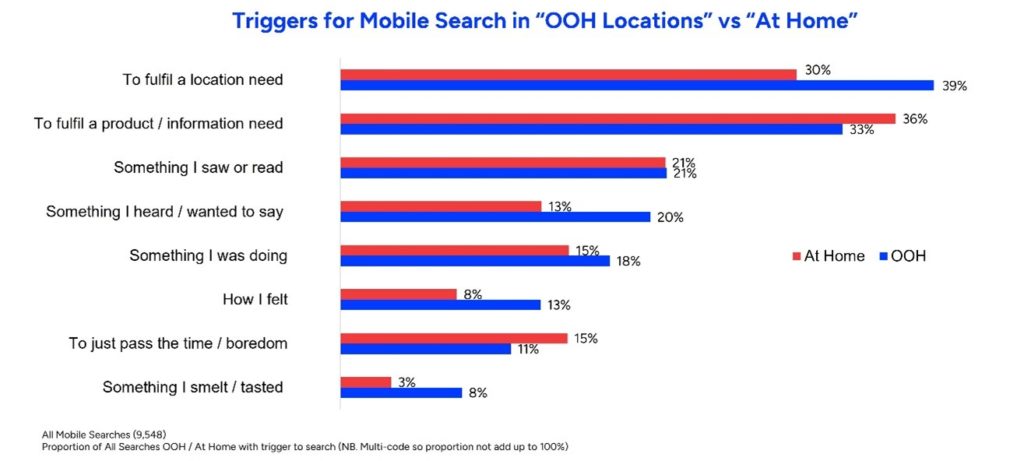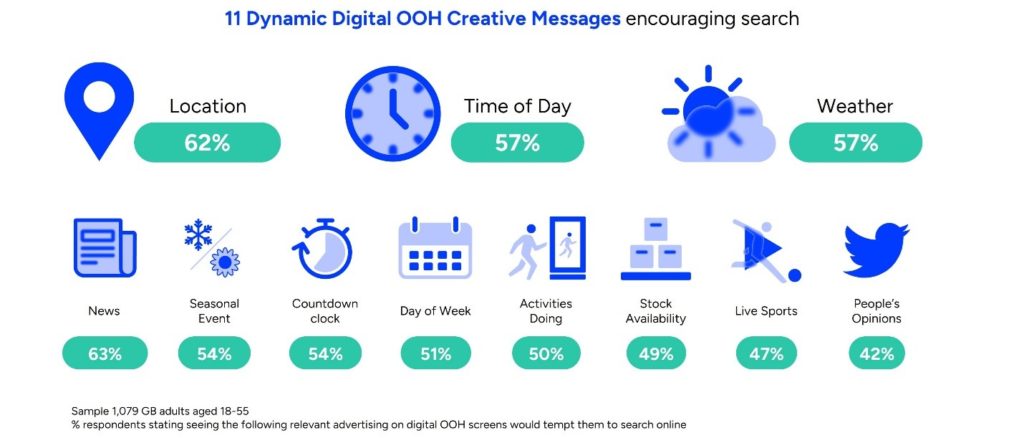The launch of a new, groundbreaking study into consumer search behaviours has revealed that mobile searches conducted out of home are much more diverse and 38% more likely to lead to a purchase compared with mobile searches conducted at home.
The study also shows that people who spend more time out of home search 58% more on their smartphones than those who spend less time out of home, and also search across more varied products and services. 62% of people are also encouraged to search when an out of home advertising campaign features a location call out.
The research study, called “The Point of Search”, was commissioned by Clear Channel UK, Global, JC Decaux UK and Posterscope, and used a combination of three research techniques in the most comprehensive study of its kind on the subject to date. Designed to understand people’s search behaviours and how they differ based by location, the research explores why people search, where they search, how the specific attributes and priming factors of the out of home space encourage search and ultimately sales, and how to optimise Out of Home (OOH) advertising to maximise the search effect.
Additional insights uncovered
The three stages of the research uncovered further new insights into consumer search behaviour out of home:
Stage 1: Anatomy of search
A comparison of Maslow’s Hierarchy of Needs with Six Core Search Typologies (as classified by Google) identified that Maslow’s need states are very much evident in these six search typologies. A national, online consumer survey then explored how these need states are reflected in people’s search behaviours and found:

- People’s search behaviour across multiple categories parallels Maslow’s Hierarchy of Need states, both in the out of home and in home environment
- People’s core need states are searched more often with “doing” and “understanding” searches, but all needs are regularly searched
- The more time consumers spend OOH, the more often they search across different categories, and out of home searches span a wider range of search typologies, need states and motivations (especially location needs) than those searches conducted in home
Stage 2: Point of search
A bespoke online search diary completed by over 1,000 people recorded their mobile search behaviour over a seven-day period, creating an in-depth database of almost 10,000 mobile searches to determine how search differs when conducted in “OOH Locations” versus “At Home”, and discovered:

- Mobile searches out of home have a wider variety of triggers, particularly location needs, the senses, and feelings:
- The number one motivation to search when out of home was to fulfil a location need e.g., to find a store address
- People are more impulsive and looking for inspiration when out of home
- Search adds value and enhances consumers’ activities and experiences
- Consumers see, hear and smell things out of home that act as triggers to search
- Consumers have many location needs when out of home and location memories act as a primer and trigger to search
- Mobile searches in out of home locations are proportionately more likely to take place Monday to Thursday, while in home searches are more likely at the weekends
- Mobile searches out of home are more spread out across time periods (over 8 in 10 taking place between the morning and 7pm), while 4 in 10 searches at home take place in the evening post 7pm
- Mobile searches out of home take place more often in the company of other people than at home searches, providing more opportunity for word of mouth
Stage 3: How to optimise OOH media to drive search
The final stage of the research looked at the specific attributes of OOH media (e.g., traditional billboards, digital OOH, etc.) that encourage people to search and identified that:

- Specific OOH media attributes drive search, such as Classic and DOOH, size, frequency, dwell time and experiential
- OOH advertising creative can be optimised by tailoring messages to needs and motivations, using specific creative messages, elements and dynamic DOOH
The study highlights the fact that search behaviour is a clear indicator of consumer needs and as a result, creative messages can be linked to these needs, and the optimisation of specific creative elements such as large logos, short succinct copy and large product shots can have a significant impact on search behaviour. While DOOH using dynamic and contextually relevant messages, such as location, weather and time also encourages people to search.
Lindsay Rapacchi, Research & Insight Director at Clear Channel UK, said: “Les Binet recently demonstrated that increases in share of search lead to increases in market share. Thanks to this new research collaboration, we also know that a huge volume of search takes place in out of home environments – clearly a target location for any brand wishing to grab hold of their share of search as and when it happens.”
Chris Forrester, Director of Commercial for Outdoor at Global added:“The results of this groundbreaking, collaborative study will arm marketeers, media planners and brands with evidence-based research that demonstrates both the effectiveness of outdoor media, and how it can be optimised to drive audience behaviour. It provides unequivocal proof that combining creativity, technology and data can really supercharge growth for brands.”
Mark Bucknell, Chief Commercial Officer at JCDecaux UK continued: “Out-of-Home advertising has been shown to amplify engagement with digital Online and this new ‘Point of Search’ insight now shows the powerful effect it has on Search, prompting people to purchase when they are outside the home. With 83% of people now visiting a city every month and the increased investment in digital Out-of-Home (DOOH) across the biggest UK cities, the opportunities for brands to get the best from the public and private screen grows ever stronger.”
Russell Smither, Head of Research and Insight at Posterscope concluded: “This research proves beyond doubt that people who spend more time out of home search more frequently on their mobiles and across a wider variety of categories, and searches conducted in out of home locations are more action orientated. Consumers are also encouraged to search in response to what they are doing, the environment around them, and by the many attributes of the OOH medium. This provides a great opportunity for advertisers to optimise their OOH media planning for even more effective results.”
Source: Posterscope

You must be logged in to post a comment Login